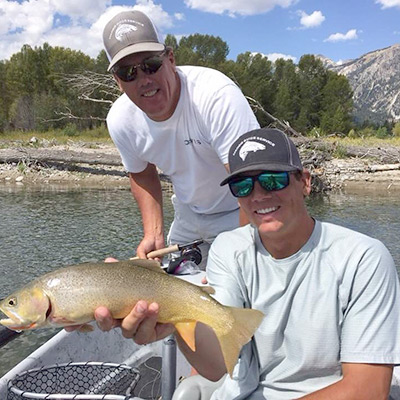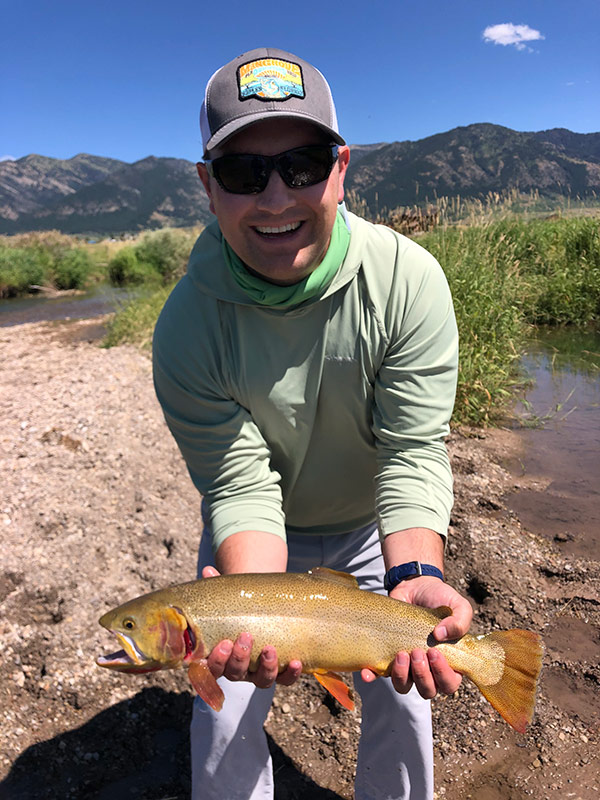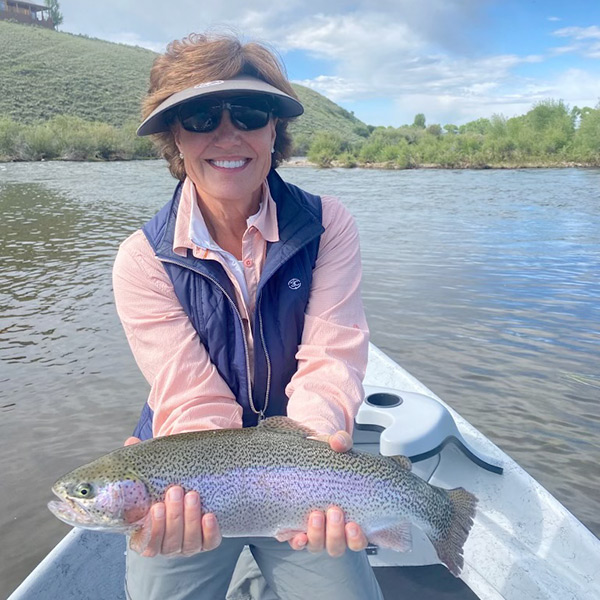
Rivers We Fish
What makes the rivers around Jackson Hole unique?
Each of the rivers we fish provides a great range of spin and fly fishing experiences. There are waters and fish for everyone from the beginner to the lifelong angler.
The Snake River — the crowned jewel of Jackson Hole

The headwaters of the Snake River are located in the backcountry of the Teton Wilderness near Yellowstone National Park. It’s named after its slithering nature and oxbow bends and is home to one of the few native trout species in the United States, the Snake River Cutthroat. The Snake is the ideal river for novice and beginner fishermen looking to catch fish on big dry flies. Fishing season on the Snake is generally from April 1 through October 31.
Beginning from Jackson Lake Dam in Grand Teton National Park, the Snake offers up to eight different floatable stretches: four within Grand Teton National Park and four outside the Park boundary. Mangis Fishing Guides specializes in the four latter sections where the Cutts are big and the fishing is outstanding.
In these lower sections of the Snake are an incredible variety of braided river channels, steep cliff banks, spring creek-like weed beds, shallow gravel bars, drop-offs, and deep pools, making it a favorite among local fly fishermen. It is not uncommon for first-time fly fishermen to hook and release 10-20 trout on dry flies ranging from 8 to 14 inches. More advanced anglers can enjoy 25+ fish days with larger fish consistently reaching the 16- to 20-inch range. In the lowest reaches of the river, below the whitewater section of the Snake River Canyon, Cutthroat and Brown trout have been recorded in the 22- to 25-inch range, usually taken on big streamer-type patterns in both early and late seasons.
The Snake in early season can be quite cold, due to its glacial-fed sources. As mid-summer approaches (mid-July through late-August), wet wading is the norm. Popular patterns in early season include Wooly Buggers, Sculpins, Zonkers and Rubber Leg stone nymphs. After runoff completes, usually by early to mid-July, dry flies begin to dominate the attention of Cutts with Royal Wulfs, Humpies, Stimulators, Trudes, Parachute Adams, and Elk Hair Caddis as standard fly box elements. On warmer days, especially in August, flies such as Chernobyl Ants, Turcks Tarantulas, Hopper imitations, and Madam-X patterns are the best bets.
Special Note
For the truly hearty and adventurous anglers, especially those looking for the largest fish of the year, consider trips in April and early May (before runoff), and again in late September and October. Some of our best fishing happens, using both dries and streamers, amid periodic snow squalls and overcast cool days.
Salt River

The Salt River flows for 70 miles along the border of Idaho and Wyoming. It starts in the Salt River Mountain Range and flows north into the Palisades Reservoir. The Salt River has numerous access points in Star Valley between Afton and the Palisades Reservoir.
Fly fishing on the Salt River is best from mid to late June all the way into November. The Salt River often clears before some other major rivers in the area. Salmonflies and Golden Stones are the first insects to pop and the Cutthroat and Brown trout take notice. Gray Drakes, Yellow Sallies, Caddis and Pale Morning Duns are also on the menu through July. August is terrestrial time on the Salt River where Grasshoppers, Ants, and Beetles bring the river’s best trout to the surface. September continues with terrestrial action, but Mahogany Duns and Blue Winged Olives dominate as October nears. Nymph and streamer fishing are the ticket towards the end of October and through November as the trophy Brown trout from the Palisades swim upstream on their spawning run.
If you enjoy pool fishing and cut banks, you’ll enjoy fishing the Salt. The fish populations are healthy, and you won’t struggle to land any.
Green & New Fork Rivers

Two of the least talked about yet most prolific fishing rivers in the Rockies are the Green and New Fork. Both begin high in the Wind River range along the Continental Divide near the towns of Cora and Pinedale, Wyoming. Originating from glaciers in the high country, these rivers flow through their own respective series of lakes before meandering slowly through sage-filled plains and grassy meadows. Though there are plenty of public access points from which to fish, the best fishing is by drift boat or raft through various stretches of river that flow through private property. Mangis Fishing Guides use both public and private access sections for its guided trips, and promises exceptional opportunities every time.
Both the Green and New Fork cut through the semi-arid plain and grass meadows where cattle, antelope and mule deer abound. Brown and Rainbow trout dominate these fisheries with fish consistently ranging from 12 to 20 inches and many topping 22 inches and larger for the experienced angler. Since neither are controlled by any impoundments or dams, water conditions are purely at the mercy of localized weather patterns and irrigation practices. Browns are best caught using big streamers and rubber leg patterns going deep, especially in early morning and late evening runs. Rainbows are active all the time and come to dry flies with reckless abandon.
Hatches on the Green are excellent in early June with an abundance of stoneflies, caddis and various mayflies. Rubber leg stone nymphs, La Fontaine Sparkle Caddis pupa, Bead Head Prince and Pheasant Tails, and Green Drakes are good choices for this time of year. Later in the month PMD’s are the ticket along with Golden Stone patterns like the Stimulator and Yellow Sallies. Elk Hair caddis can do great in late afternoon and evening hours. On either river, late evening into dusk can be a magical time as big browns leave their hidden undercut banks in search of prey as the sun begins to set. Browns over 10 pounds have been taken many times on patterns such as Matuka Sculpins, Muddler Minnows, Pepperoni Yuk Bugs, and one of our favorites, the Kiwi Muddler.
Special Note
Like the Snake, some of the biggest fish of the year will be caught in both early and late season. If you don’t mind the chance for inclement weather, clients are often richly rewarded for their persistence in these chillier periods.

